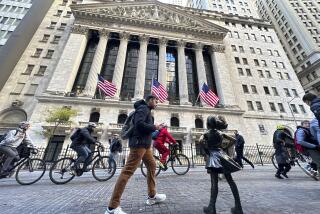Price of Oil Continues Its Upward March
- Share via
After dancing above $50 a barrel, oil prices closed just below that milestone Tuesday, renewing concerns about the damage high energy prices are inflicting on the economy.
The bellwether light crude oil for November delivery on the New York Mercantile Exchange rose 26 cents to $49.90 a barrel, its third record high in as many sessions. Earlier in the day, oil climbed as high as $50.47 a barrel.
Prices have soared 75% in the last 12 months because demand for oil and its refined products, such as gasoline and diesel fuel, has risen sharply while supplies have been constrained even though producers are pumping at near capacity.
Hurricane Ivan exacerbated the problem by knocking out nearly one-third of the oil production in the Gulf of Mexico. Repairs to oil platforms have been slow.
The lofty prices also reflect traders’ fears that political unrest or terrorism in oil-exporting nations will disrupt precarious global supplies, leading to shortages. Their newest fear is the threat of civil war in Nigeria, a member of the Organization of the Petroleum Exporting Countries, and the prospect that Nigeria’s output of 2.2 million barrels a day could be interrupted. Nigeria accounts for 8.1% of OPEC’s official daily production quota of 27 million barrels for its 10 member nations, excluding Iraq.
OPEC’s top producer, Saudi Arabia, tried again to calm the markets Tuesday by saying it would enlarge its oil-production capacity to 11 million barrels a day from 10.5 million in the coming weeks.
The boost in capacity would enable the Saudis to quickly increase actual production, providing a small cushion if supplies are disrupted elsewhere. But prices rose anyway Tuesday, just as earlier OPEC production hikes this summer failed to stop crude from reaching new peaks.
Insurgents’ bombings of Iraqi oil pipelines in recent weeks have contributed to oil’s rally. Iraq produces 1.5 million to 2 million barrels a day.
Although oil prices are hitting nominal records almost daily, they remain below their levels of the early 1980s, when adjusted for inflation. But that’s of little solace to users of oil, gasoline and other refined products.
The average price of self-serve regular gasoline in California, at $2.094 a gallon, was 18.2 cents higher than a year ago, the Energy Department’s Energy Information Administration reported Monday.
Prices of diesel fuel, used by the trucking and railroad industries, also are surging. The average diesel price in California jumped 8.4 cents, to $2.236 a gallon, in the latest week, and the nationwide average diesel price soared 10 cents a gallon to $2.012 -- the first time it has surpassed $2 a gallon since the Energy Information Administration began tracking the figure a decade ago.
All of this is leaving motorists, truckers, shippers, the airlines and other businesses with fewer dollars to spend elsewhere, and that’s causing a drag on the economy.
Just ask Terrence Hill. At a Chevron station near his San Pedro home, Hill arrived in his new 2005 Nissan Altima, with its 250-horsepower V6 engine, for its inaugural fill-up Tuesday. He peeled off $35 in cash, confident that would be enough to fill his 20-gallon tank with premium gas, which had jumped to $2.33 a gallon from $2.29 overnight.
He was wrong.
“This is terrible,” Hill said after realizing his tank was still a couple of gallons shy of being full. At these prices, he added, motorists “will just put in as much fuel as they need to get to where they want to go.”
Major retailers such as Wal-Mart Stores Inc. have posted slim sales gains in recent weeks, which analysts attributed in part to shoppers having less disposable income because their fuel bills are climbing.
Consumer confidence also fell again in September after declining in August, the Conference Board research group said Tuesday. High energy prices are partly to blame, analysts said.
As with everything these days, the rising prices sloshed over into the political arena. Democratic vice presidential candidate Sen. John Edwards blamed the unrest on the Bush administration’s “mismanagement of Iraq.”
The White House shot back that high gas prices are the fault of Edwards and other Democrats for blocking President Bush’s effort to develop an energy plan that would reduce U.S. oil imports.
Skyrocketing oil prices also have dogged the stock market for months. Yet on Tuesday, investors shrugged off oil’s latest increase and the consumer-confidence report and lifted the Dow Jones industrial average back up above 10,000. The blue-chip average rose 88.86 points to 10,077.40.
Analysts are divided over how soon oil prices might ease.
“Much depends on developments in regions where supply concerns have intensified: the Middle East, Russia and Nigeria,” James Burkhard, director of world oil analysis for the consulting firm Cambridge Energy Research Associates, said in a note to clients.
Prices might stay high at least through this week, especially if the government’s weekly report on U.S. oil supplies today shows another decline, analysts said. Inventories already were below last year’s level, thanks in good part to Hurricane Ivan.
But oil prices should fall next year to below $40 a barrel as supplies increase and fears of shortages ease, investment bank J.P. Morgan & Co. predicted Tuesday.
“Basically, what I’m looking for is a sustained high price through the winter months, but I think that if we’re going to see a substantial price decline it’ll be in the second quarter” of 2005, J.P. Morgan analyst Katherine Spector said during a conference call.
Staff writer Ronald D. White and Times wire services contributed to this report.
More to Read
Inside the business of entertainment
The Wide Shot brings you news, analysis and insights on everything from streaming wars to production — and what it all means for the future.
You may occasionally receive promotional content from the Los Angeles Times.











